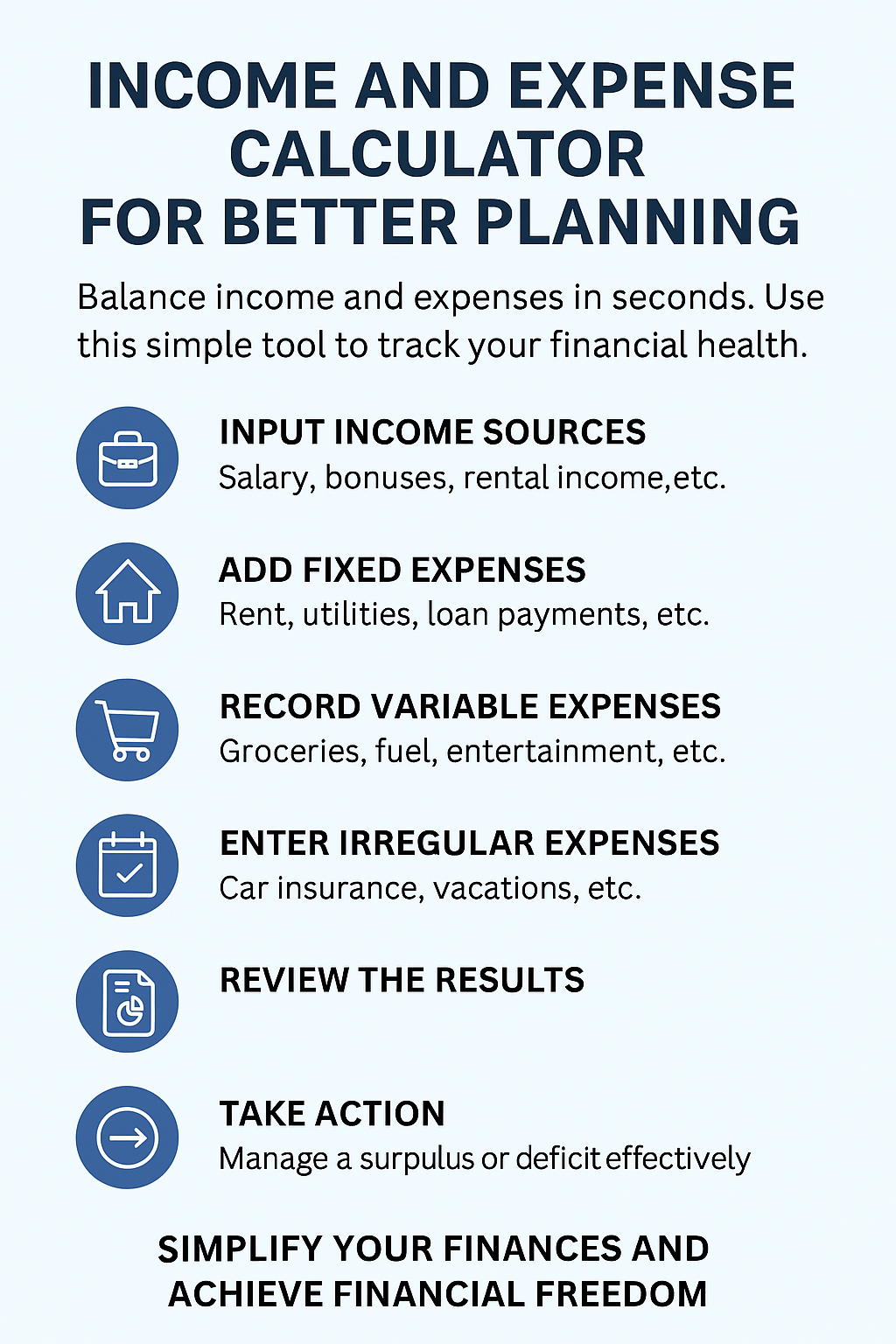Managing money effectively is the cornerstone of financial stability. Whether you’re a student, working professional, or managing a household, understanding your cash flow is vital to building long-term wealth. Unfortunately, many people underestimate how quickly small expenses add up or how easily overspending can derail savings.
That’s where an income and expense calculator comes in. This simple yet powerful tool gives you instant clarity about your financial situation, helping you make smarter choices about spending, saving, and investing. In this guide, we’ll explore how an income and expense calculator fits into the bigger picture of personal finance, why it’s a must-have tool, and how to use it for better financial planning.
What Is Personal Finance and Why Is It Important?
Personal finance is the practice of managing your money to achieve financial goals. It includes budgeting, saving, investing, debt repayment, and retirement planning.
Here’s why it matters:
- Financial Security: Helps you pay bills on time and avoid debt traps.
- Future Planning: Supports goals like buying a house, funding education, or retirement savings.
- Reduced Stress: A clear plan brings peace of mind and avoids money-related anxiety.
- Freedom of Choice: With smart money management, you have more control over how you live your life.
Without a plan, even high earners can end up in debt. With the right tools—like an income and expense calculator—you can gain control over your financial future.

What Is an Income and Expense Calculator?
An income and expense calculator is a digital tool designed to balance your financial inflows (income) with outflows (expenses).
It works by:
- Tracking income sources (salary, side hustles, benefits, rental income).
- Listing expenses (housing, utilities, transport, groceries, entertainment).
- Calculating net balance (income minus expenses).
- Highlighting financial gaps (deficit or surplus).
- Providing actionable insights for saving or reducing unnecessary costs.
💡 Tip: Use our free Income and Expense Calculator to instantly see where your money goes each month.
Why You Need an Income and Expense Calculator
Budgeting isn’t about restriction—it’s about direction. Here’s why using a calculator can transform your financial health:
- Instant Awareness: Know exactly how much you earn versus how much you spend.
- Identify Leaks: Spot wasteful habits like unused subscriptions or frequent takeaways.
- Boost Savings: Free up funds for goals like a holiday, emergency fund, or investments.
- Manage Debt: Allocate extra money to clear debts faster.
- Plan Smarter: Prepare for irregular expenses such as car repairs or birthdays.
How to Use an Income and Expense Calculator (Step-by-Step)
Step 1: Input Income Sources
- Salary (after tax)
- Bonuses or freelance earnings
- Benefits, pensions, or rental income
Step 2: Add Fixed Expenses
These are non-negotiable bills you pay monthly:
- Rent or mortgage
- Utilities
- Insurance
- Loan repayments
Step 3: Record Variable Expenses
Costs that change month to month:
- Groceries
- Fuel or public transport
- Entertainment
- Shopping
Step 4: Enter Irregular Expenses
Annual or quarterly payments like:
- Car insurance
- Holidays
- School fees
Step 5: Review the Results
The calculator will show:
- Total income
- Total expenses
- Remaining balance (surplus) or overspending (deficit)
Step 6: Take Action
- Surplus? Redirect it to savings, investments, or debt repayment.
- Deficit? Identify where to cut back and create a more realistic spending plan.
Budgeting Methods You Can Apply
Once you have the results from the calculator, you can apply different budgeting strategies:
1. The 50/30/20 Rule
- 50% needs (housing, utilities, food)
- 30% wants (entertainment, lifestyle)
- 20% savings and debt repayment
2. Zero-Based Budgeting
Every pound is assigned a purpose—nothing is left unplanned.
3. Envelope Method (Cash or Digital)
Divide money into categories and stop spending once each “envelope” is empty.
Using the income and expense calculator makes it easy to align with these methods.
Common Mistakes to Avoid
Even with the right tool, families and individuals make these mistakes:
- Not updating regularly: Expenses change monthly, so must your budget.
- Ignoring small purchases: Coffee runs or app subscriptions add up.
- Forgetting annual expenses: Birthdays, car servicing, holidays.
- Being unrealistic: Setting goals too high can lead to frustration.
- Not involving the family: A household budget only works when everyone is on board.
Real-Life Scenarios
- Young Professional
Uses the calculator to track salary and weekend spending. Finds they’re spending £200/month on eating out, redirects half to savings. - Family of Four
Uses it to monitor groceries, childcare, and transport. Identifies £150/month wasted on unused subscriptions and reallocates to an education fund. - Debt Repayment Journey
A couple enters all debts into the calculator. By cutting back lifestyle costs, they free £300/month to pay down credit cards faster.
FAQs on Personal Finance and Calculators
Q1: How often should I use an income and expense calculator?
At least once a month, or whenever your income/expenses change.
Q2: Can budgeting help reduce debt?
Yes, by showing exactly how much extra can go towards repayments.
Q3: Do I need a high income to benefit from budgeting?
No—budgeting benefits everyone, regardless of income level.
Q4: What if my expenses are higher than my income?
Start by cutting unnecessary spending and look for ways to boost income.
Q5: Are online calculators safe?
Yes, as long as you use trusted tools that don’t request personal banking details.
Conclusion: Simplify Your Finances Today
Personal finance doesn’t have to be complicated. With an income and expense calculator, you can get a clear view of your money, balance your spending, and set realistic goals in minutes.
By tracking your cash flow, you’ll gain control over your finances, reduce stress, and move closer to financial freedom.
💡 Ready to start? Try our Income and Expense Calculator now and take the first step towards smarter money management.
